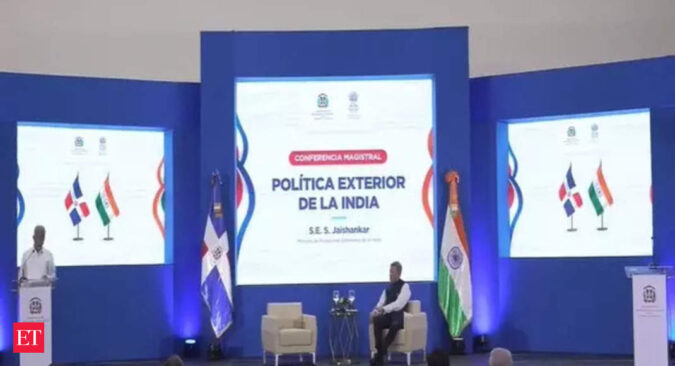The EAM made the above remarks while apprising the diplomatic corps and students in the Dominican Republic about India’s engagement with Latin America.
During his speech, Jaishankar spoke on three themes: How does India approach the world and secure its growing global interest; How is India engaging Latin America; What should India – today’s and tomorrow’s – mean to you (Dominican Republic).
Following his speech, Jaishankar tweeted, “Happy to speak to diplomatic corps and young minds of the diplomatic school of @MIREXRD, Dominican Republic. Offered my thoughts on – How does India approach the world? How is India engaging Latin America? What should India – today’s and tomorrow’s – mean to them? Watch my speech to know the answers.”
The External Affairs Minister, during his first official visit to the Dominican Republic, while speaking further on India’s engagement with Latin America said, “In the last decade there has been a conscious deepening of this process. Our trade with Latin America is today approaching a volume of USD 50 billion. Our export to Brazil at USD 6.48 billion is more than Japan at USD 6.18 billion. That to Mexico at USD 4.43 billion is more than to Canada at USD 3.7 billion. In fact, with the Dominican Republic, our exports at USD 329 million is more than some ASEAN partners. The deeper globalization and a broadening of India’s interest, Latin America is no longer considered a region too far.”
Underlining India’s growing investments, he said, “Surge in investments in the energy sector, India today imports crude from Brazil, Mexico, Colombia and Guyana. Our presence in sectors like IT, pharma and two-wheelers is increasing.”
Jaishankar also noted India’s growing political coordination with regional blocs of Latin America, “The political engagements are growing in parallel. Since 2016, we have a structured engagement with CELAC. Similarly, there is an arrangement to regularly interact with CARICOM and SICA. India is an associate member of Pacific alliance.”Explaining the students of diplomacy about what should India – today’s and tomorrow’s – mean to them, Jaishankar said that as the fifth largest economy, India’s economic presence will be more strongly felt in this region.
“Not just as a most populous country but also one of growing skills and talent, we are becoming increasingly central to the global workplace. The big change of our era is digital revolution. In that sense, India’s digital experience holds lessons for the world,” he said.
Noting other major steps taken by India, Jaishankar said, “A parallel story is taking place in the domain of health. Covid period recognised India’s true potential in health sector. In a world that is more self-obsessed India has stepped in providing humanitarian assistance.”
Prior to this, the External Affairs Minister stated the different aspects of “How does India approach the world?”
“Like any other country, India’s most pressing priorities are in its neighbourhood. Given its size and economic strength, it is very much for the collective benefit that India takes generous and non-reciprocal approach to cooperation with smaller neighbours.”
Jaishankar also explained them India’s Neighbourhood First Policy, which focuses on peaceful relations with its South Asian neighbours.
He said, “This what we have done in the last decade under the leadership of PM Modi and Neighbourhood First Policy. It has seen a dramatic expansion in connectivity, contact and cooperation across the region. The exception to this is, of course, Pakistan in view of the cross-border terrorism it supports,” adding, “Whether it is the Covid challenge or more recent debt pressure India has always stepped up for its neighbours.”
Jaishankar, in his lecture, explained India’s global ties in all directions. He said, “Beyond South Asia, India is developing a concept of extended neighbourhoods, in all directions. With ASEAN, this has taken the form of what we call the Act East Policy that has opened up a pathway to a deeper engagement with the Indo-Pacific that is being pursued amongst others through a mechanism, called the Quad.”
“Towards the West, there has been a perceptible intensification with India’s relationship with the Gulf and with the Middle East. One reflection of that, is a new grouping called I-2U-2, comprising India, Israel, UAE, USA,” he added.
The External Affairs Minister also said, “To the South, the outlook that shapes India’s thinking goes by the acronym of Sagar, an Indian word for oceans. First time in 2015, PM Modi articulated a comprehensive view that span the entirety of Indian oceans and its islands. These subsequently became the building block for the Indo-Pacific vision that merged thereafter.”
He added, “To the North, India has been pursuing a strategy of connecting to Central Asia more effectively and this has taken the form of structured engagements across multiple domains.”
On Friday, Jaishankar arrived in Santo Domingo, Dominican Republic for his first official visit to the country.
